Depth and height of the sink: types of installation
Most often, the height of the sink from the floor is determined by the structure on which it is fixed - a cupboard, pedestal or pedestal. And there is always a standard size of 80-83 cm, unless, of course, the bowl is not consignment.
This is the best option for a person of average height, but you can vary this parameter based on your own needs - the easiest way to do this is with a hanging sink. Below we will talk about the methods of installation and see the selection of videos in this article.
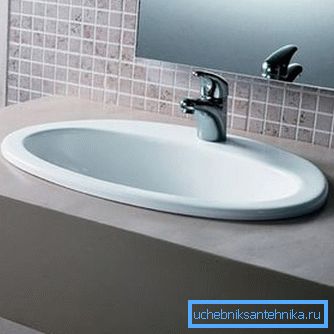
Different shells
What can be installation
Note. The installation of the bowl may depend on the material, that is, it will determine at what height the sink or in what way it is fixed to the table top. Bowls are made of porcelain, earthenware, glass, artificial granite or marble, as well as stainless steel (kitchen sink). The highest price for artificial marble, granite and glass.
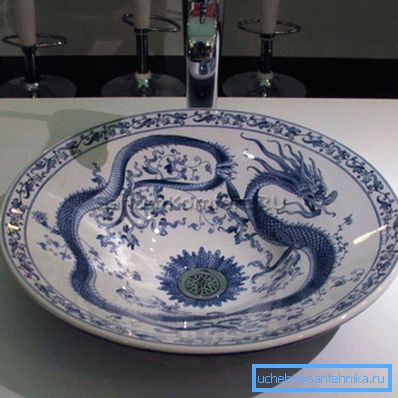
- First of all, it should be noted that the height of the cabinet under the sink always remains the same - it is 80-83 cm (depending on the legs), in rare cases it can reach 85 cm, but this is not felt visually. But this indicator can be higher, if it is an invoice option - here everything will depend on the depth of the bowl and the height of the cupboard (cabinet) for its installation.
- For example, porcelain bowls are most often mounted as overhead to show the beauty of the material, and thus glass is installed.. So such products with the installation of invoices may be higher than recessed or mortise bowls of sinks.
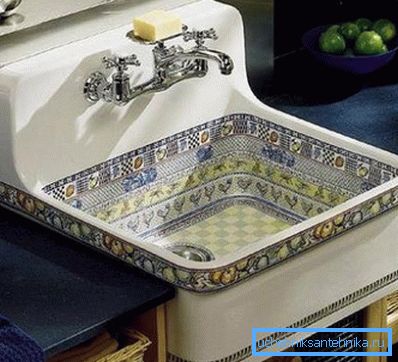
- More dependent on the height of the cabinet or cabinet for the sink invoice option, that is, when the bowl is inserted into the seat, and its sides remain at the top (if the cabinet has 80 cm, the height of the sink will be about 82 cm). This is the most common method of installation, moreover, overhead metal sinks in the kitchen are installed according to the same principle - the side walls are designed to fit a bowl of a certain size.

- And, finally, the last and most difficult option is when the sink runs flush or below the table top - there is a special installation instruction and for this kind of work you need some experience.. In these cases, we are not talking about height at all, since this parameter is entirely dependent on the height of the cabinet or cabinet, but it usually has a standard value.
Assembly work

To begin with, what should be the height of the conclusions under the sink and you see it in the upper image. Although this is by no means mandatory - the size (length) of the connecting hoses allows it to be done at any distance.
However, the most convenient position is 66-68 cm - so the hoses do not have to go through the shelf - they are almost a bit lower than the sink. But this is not always possible, as they do not allow technical capabilities, so this parameter (66-68 cm) can be simply held as the most optimal reference point.
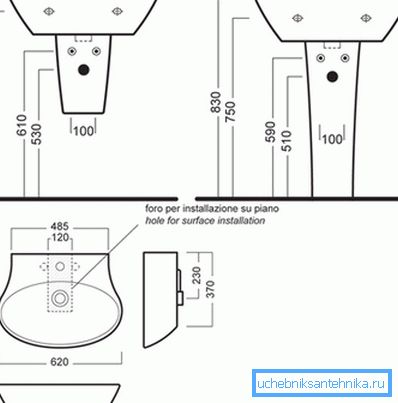
The same principle (in order not to hurt the middle shelf) determines the optimum height of the sewer for the sink - this can usually be in the range of 50-53 cm, that is, just below the hot and cold pipe fittings.
But, again, this option is not always possible - most often, the exact wiring is carried out when the walls are sheathed with plasterboard (clapboard) or with a deep plastering, which is possible only with sufficiently thick walls (partitions). In cases where the sink is suspended, these parameters (for plumbing and sanitary) should be performed as accurately as possible.
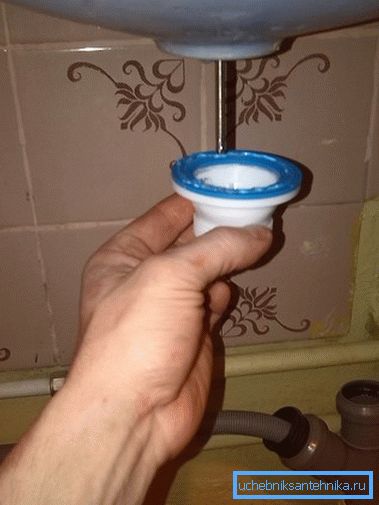
Do-it-yourself installation of the sink always begins with fastening a mixer and a siphon grill to it. That is, these elements are much more convenient to install on a removed bowl in order to provide the most favorable access to the fixation elements.
You will have to disassemble the siphon completely to install all the gaskets as accurately as possible, but this will be later. First of all you screw the drain grid, but do not confuse the rubber gaskets - keep the order of the factory assembly.
Note. Siphon for metal and ceramic (marble, granite) sink differs in length of the bolt. So, the bolt is longer on ceramics than on metal, and if you easily install a siphon with a long bolt on a metal sink, then a short bolt on the ceramics will not be installed.
Similarly, screw the mixer to the sink, only before that, you need to install connecting hoses on the faucet - it is much more convenient than doing this when the sink is installed.
Fixing the mixer (the price does not matter) is carried out either with the help of a nut, which is screwed onto the body, or with the help of studs with nuts and a special metal washer with gaskets. In any case, it is much more convenient to fasten the tap with the screwed-in nozzles, rather than doing it later, after installing the sink.
Still, no matter how tall the sink is, it is often attached to the wall - this method of fixation is provided for almost all types of recessed bowls - the back wall is fixed to the wall with dowels. As a rule, this method of fastening is provided for bathrooms and toilets.
Conclusion
As you can see, the standard height of the shell practically does not change in any case - it is focused on the height of the belt of an average person's height (slightly higher or lower). Moreover, this parameter remains the same for the kitchen, bath and toilet - after all, the same occupant will still use the sanitary unit.